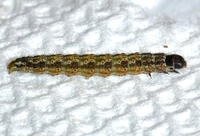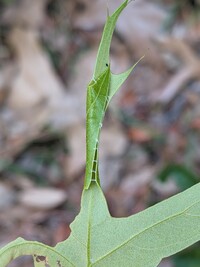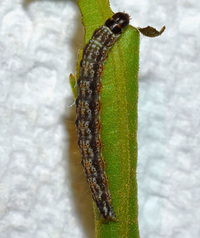Taxonomy
Superfamily:
Family: Subfamily: Tribe: P3 Number: MONA Number:
Comments: The genus Chionodes is the most species rich genus of gelechiid moths in the Western Hemisphere, with 187 recognized species. Our knowledge of the diverse array of species in North America is largely due to the monumental work of Hodges (1999), who spend decades working on the group and described 115 new species (Powell and Opler, 2009). Many exhibit substantial variation within species and have drab coloration, typically with brown, dark gray, or blackish patterning on the forewings. These can only be confidently identified by examining secondary sexual characteristics and/or the genitalia of one or both sexes. Others are more boldly marked and can be identified by wing patterning. Many of our state records are based on Hodges (1999) database of over 19,000 specimens that he examined from major collections in the US. These include North Carolina specimens that he collected mostly from Highlands, and from a few other areas within the state.
Identification
Adult Markings: The following description is based on that of Hodges (1999). The labial palp is pale luteous and suffused with light brown in the brush. The second segment is irrorate with blackish fuscous exteriorly, while the third segment is blackish fuscous. The head is ocherous-white to sordid white, with the scales brown to fuscous-tipped. The antenna is blackish fuscous with light-brown annulations. The ground color of the thorax and forewing is light-brown. A moderately large, blackish-fuscous spot is on the costa at the basal third. Elongated blackish-fuscous spots are present on the fold just before the middle of the wing, in the center of the cell, and at the end of cell. The apical third of the wing is fuscous and bisected by a pale, outwardly angulate, transverse fascia at the apical fourth. The cilia are light yellowish fuscous, mixed with fuscous. The hindwing is pale gray basally, and shades to dark fuscous apically. The legs are ocherous-white and suffused and banded with fuscous. The abdomen is light fuscous above, with the posterior edges of the segments narrowly bordered with ocherous-white to sordid white. This species is best identified using genitalia or by rearing from larvae.
Wingspan: 16-18 mm (Clarke, 1947)Forewing Length: 6.8-8.9 mm (Hodges, 1999)
Adult Structural Features: Hodges (1999) has descriptions and illustrations of the genitalia.
Genitalia and other structural photos
Adult ID Requirements: Identifiable only by close inspection of structural features or by DNA analysis.
Immatures and Development: The larvae feed on a variety of oak species. Marquis et al. (2019) noted that the larvae in Missouri tie leaves during the spring and early summer, with the adults emerging mainly in June and July. Wagner et al. (1995a) collected numerous C. pereyra from the oak canopy in Virginia. The mature larva has a black head and a prothoracic shield that is black except for a cream-colored anterior margin. The abdomen has a dull-yellowish ground color and often has two faint, thin, and broken mid-dorsal longitudinal stripes. There are also black dorsal pinacula that appear as four small black dots in the center of each body segment (Marquis et al., 2019). The abdomen and thorax have two broad, strongly contrasting, subdorsal longitudinal black stripes of irregular width, while the dorsum of A9 is marked with a thick, black, mid-dorsal line (Marquis et al., 2019).
Larvae ID Requirements: Identifiable from good quality photos, especially where associated with known host plants.

 »
»



 »
»

